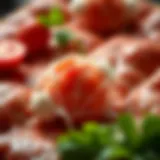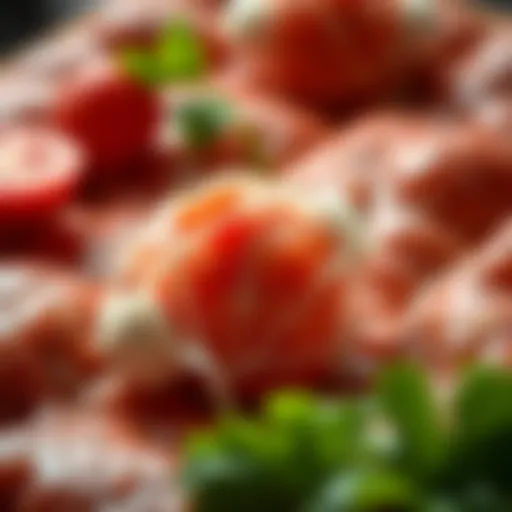Shelving Solutions for Cookbooks: A Complete Guide
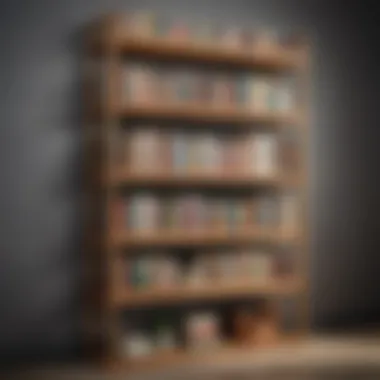

Intro
In a world where culinary exploration thrives, the role of cookbooks transcends mere recipes. For food lovers, they are often cherished artifacts, offering not just instructions but also inspiration. Yet, as any passionate home chef knows, the challenge lies not just in acquiring a grand collection of cookbooks but also in organizing them effectively. In the confined spaces of a kitchen, every inch counts. This guide focuses on shelving solutions specifically tailored for cookbooks, ensuring they remain accessible and aesthetically pleasing.
Space Optimization
Navigating the world of shelving requires an understanding of how to maximize space. Kitchens are often bustling environments, and areas dedicated to cookbooks can easily become cluttered. One effective strategy involves considering the vertical dimensions of your kitchen. Utilizing tall shelves can provide ample storage without consuming precious floor space. Furthermore, adjustable shelves allow for flexibility in organizing varying book sizes, ensuring everything from that hefty tome on French cuisine to a slender volume of quick weeknight dinners finds its perfect spot.
Choosing the Right Material
When it comes to selecting materials for your shelves, it’s crucial to balance durability and aesthetic appeal. Here’s a breakdown of common shelving materials:
- Wood: Offers warmth and character, perfect for traditional kitchens. Consider oak for its strength or pine for a more budget-friendly option.
- Metal: Ideal for modern aesthetics, metal shelving can lend a sleek, industrial feel to your kitchen. Stainless steel is particularly easy to maintain.
- Glass: Adds a touch of elegance while allowing you to showcase the beauty of your cookbook collection. Keep in mind, though, glass shelves require careful handling and cleaning.
"The right shelving can transform your cookbook collection from a jumbled heap into an organized gallery of inspiration."
Functional vs. Decorative Elements
Organizing cookbooks isn’t just about practicality; it’s also an opportunity to express personal style. To create a visually impactful display, think about incorporating both functional and decorative elements. Here are some ideas:
- Thematic Grouping: Organize books by genre or region. Having all Italian cookbooks together not only makes them easy to find but can also create a delightful visual story.
- Bookends: Use stylish bookends to keep your collection tidy. These can be functional or decorative, perhaps in the shape of herbs or kitchen tools.
- Lighting: If you’ve got glass shelves, consider adding LED lights underneath. They can illuminate the spines of your cookbooks and create a cozy, inviting atmosphere.
End
In summary, effective shelving for cookbooks is more than just a practical concern; it’s a creative opportunity. By understanding the intricacies of space optimization, material selection, and organizational techniques, culinary enthusiasts can craft an environment that not only serves its purpose but also inspires culinary adventures. From the frantic weeknight rush to leisurely weekend experiments, a well-arranged cookbook collection can be a constant source of motivation within your kitchen.
Understanding the Importance of Cookbook Storage
When it comes to whipping up culinary delights, the recipes we cherish play a pivotal role in our kitchen experiences. Cookbooks provide more than just instructions; they serve as gateways to vast culinary explorations, offering diverse ideas and techniques that broaden our gastronomic horizons. This section delves into the significant aspects of cookbook storage, illustrating why it is indispensable for both novice cooks and seasoned chefs alike.
The Role of Cookbooks in Culinary Exploration
Cookbooks are much more than mere collections of recipes. They are repositories of culture, history, and creativity that provide a glimpse into the chef's mind. Each cookbook reflects the personal journey of its author, encapsulating regional flavors and time-honored techniques. For instance, a rustic Italian cookbook might beckon readers to discover the secrets of homemade pasta, while a modern vegan book introduces plant-based innovations.
Furthermore, cookbooks inspire experimentation. With every turn of the page, chefs can explore different cuisines, challenge their skills, and even know the art of flavor combinations that they might have previously never considered. A well-curated collection thus becomes a treasure trove of knowledge—just waiting for culinary enthusiasts to dive in.
Benefits of Organized Cookbook Shelving
Now, let’s shift gears to the practical side—organization. When cookbooks are organized effectively, it transforms your cooking practice and makes life in the kitchen that much easier. An organized space contributes to a more enjoyable cooking experience by reducing stress and enhancing efficiency.
Here are several advantages of having a well-structured cookbook shelving system:
- Ease of Access: A neatly organized shelf allows you to quickly locate a specific cookbook, saving precious time when you're in a rush or preparing for guests.
- Visual Appeal: Cookbooks showcased in an inviting manner can elevate the aesthetic of the kitchen. Think of colorful spines lined up or thematic displays that pique interest.
- Space Optimization: Strategic shelving can maximize available space—whether it's utilizing vertical storage or cleverly fitting cookbooks into unconventional nooks. This not only makes the area look cleaner but also makes each cookbook easy to reach.
- Cultivating a Culinary Culture: An organized collection encourages more frequent cooking, thereby nurturing your culinary skills and inviting family and friends to share in the experience.
Assessing Your Space
When it comes to storing cookbooks, assessing your space isn’t just a practical step; it’s the foundation upon which all subsequent decisions will be made. Without a thorough understanding of your kitchen's layout and available areas, you might find your cookbook collection cluttering countertops or tucked away in boxes, far from the cooking action. Making the most of your space means maximizing accessibility while ensuring that your beloved cookbooks are displayed nicely.
Identifying Available Space in the Kitchen
The first step in organizing cookbook storage is to pinpoint exactly where they can belong in your kitchen. Look around and get a sense of what you’ve got. If the kitchen seems bustling with appliances, furniture, and everything in between, fear not. Start with the walls. You might have shelves that are begging for a book or two to sit pretty, or perhaps there's room on top of your fridge, that often-overlooked spot.
- Consider these areas:
- Wall-mounted shelves
- The top of cabinets
- Corner spaces that often go unused
- A nearby dining room that can act as an extension of your kitchen space
Taking note of your kitchen's corners or even behind doors can lead to unexpected solutions. When you spot all these available spaces, you're laying the groundwork for an organized and stylish display of your cookbooks, turning what once may have seemed like a mess into something functional.
Understanding Kitchen Layouts
Next, it’s crucial to understand the general layout of your kitchen. Different configurations require tailored approaches to shelving solutions. Whether your kitchen is galley-style, L-shaped, or open-plan, each presents unique opportunities and challenges for cookbook organization.
- For a galley kitchen:
- In an L-shaped kitchen:
- Open-plan settings offer a different challenge, as cookbooks can be seen from various angles. Here, decorative elements on your shelving can enhance the overall aesthetic while keeping your books accessible.
- Think vertical. Wall space is at a premium, so consider floating shelves that draw the eye upward. High placements are manageable if you have a step stool handy.
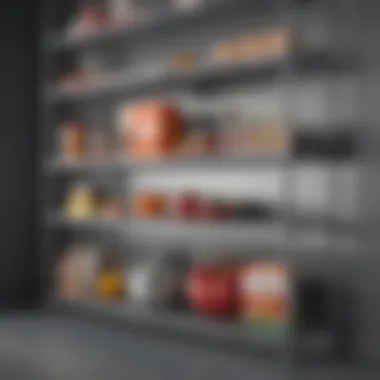

- You have options on two separate walls. Freestanding bookcases can fit snugly against a wall and can be a statement piece.
Understanding the unique layout not only helps in deciding on the style and type of shelving but also enables you to visualize which cookbooks complement certain areas of your kitchen. This kind of detail is what turns a simple collection of books into a curated display, making it easy to find that one recipe you’ve been meaning to try.
"The kitchen is often the heart of the home; optimizing it makes it not just functional but inviting."
The journey of organizing your cookbook collection starts with careful assessment. With this groundwork laid, you can next move on to exploring diverse shelving solutions that suit your kitchen's personality.
Types of Shelving Solutions
The way you choose to shelve your cookbooks can either elevate your kitchen aesthetics or leave you feeling like you’re fighting an uphill battle with clutter. It’s crucial to think about the types of shelving solutions available, focusing on what fits both your practical needs and design sensibilities. The right shelving not only displays your culinary treasures neatly but also keeps them within reach while cooking. Thus, exploring various shelving options plays a pivotal role in maximizing your kitchen space’s functionality and style.
Built-in Shelves
Built-in shelves are a fantastic way to create a seamless storage solution within your kitchen. They can be designed to fit specific spaces, making them a great option for those awkward corners or recesses that freestanding furniture can't tackle. Moreover, they can be customized to match existing cabinetry, providing a cohesive look.
- Pros:
- Cons:
- Maximizes every inch of space.
- Integrated design enhances overall kitchen aesthetics.
- Can be tailored to hold various cookbook sizes.
- More permanent solution; less flexibility in rearranging.
- Requires professional installation, which can be costly.
When considering built-in options, remember to think about accessibility. Low shelves might be great for reach but could limit visibility, while higher units may require a step stool. Balancing accessibility with visual appeal is key.
Freestanding Bookcases
Freestanding bookcases offer a versatile shelving option with an added flexibility that built-ins can’t provide. You can shift them around the kitchen or even take them with you if you ever move. Coming in various styles—from rustic to contemporary—these units can embrace individuality while serving as functional storage.
- Pros:
- Cons:
- Easily movable for redesigning your cooking space.
- Various styles, sizes, and finishes available, catering to different personal tastes.
- Often less expensive compared to built-in options, making them appealing for budget-conscious cooks.
- May occupy floor space, potentially making kitchens feel cramped.
- Stability concerns; some units might require wall anchoring.
With freestanding bookcases, think about the size and how many books you routinely reference. This type of solution welcomes a more collected look, where cookbooks can be paired with decorative items like plants or small kitchen gadgets.
Floating Shelves
If floor space is at a premium, floating shelves provide a chic alternative that offers open storage. These shelves give your cookbooks the illusion of weightlessness while still offering substantial support. They can be positioned at various heights, working well in tight spots.
- Pros:
- Cons:
- Creates the appearance of a larger space by freeing up floor area.
- Adds personality and can highlight cookbooks as art pieces.
- Often easy to install, providing a DIY-friendly option.
- Might not hold as much weight as traditional shelving.
- Requires proper installation to avoid accidents.
Floating shelves can be particularly striking when arranged in a staggered pattern along a wall. This playful approach provides not just a visual interest but also makes access to a specific cookbook effortless—perfect for those last-minute dinner instructions.
Specialty Cookbooks Racks
For the cookbook aficionado, specialty racks designed expressly for holding and showcasing cookbooks can be a delightful addition. Designed with cooks in mind, these racks can accommodate cookbooks of varying sizes and offer unique designs to showcase your collection.
- Pros:
- Cons:
- Offers a dedicated space for cookbooks without mixing them with other items.
- Racks often come in colorful and creative designs, adding flair to kitchen decor.
- Typically adaptable; some can hold tablets or recipes on display.
- Limited capacity; may not be ideal for larger collections.
- Some designs could clash with kitchen aesthetics if not chosen wisely.
These specialty options can enhance not just storage but celebrate the love for cooking. They can either stand alone or become part of a larger shelving unit, offering a focal point in your kitchen.
Taking time to explore these types of shelving solutions can lead to a worthy investment in your culinary workspace. The right choice not only meets your storage needs but elevates the visual language of your kitchen as well.
The ideal shelving solution communicates your passion for cooking while providing accessibility and organization to your beloved cookbook collection.
Material Considerations
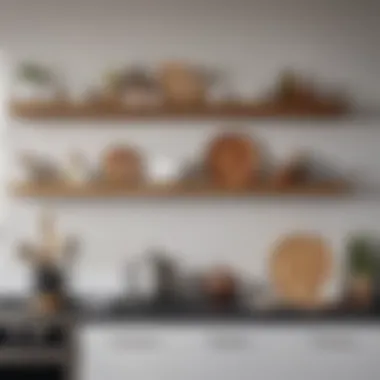

Choosing the right material for your cookbook shelving isn't just about aesthetics; it can significantly impact the overall durability, functionality, and design of your kitchen space. Each material brings its own set of advantages and drawbacks, which can either complement or clash with your kitchen's existing décor. Understanding these elements helps you make an informed decision that suits both your style and your needs.
Wood: A Classic Choice
Wooden shelves are the quintessential choice for many kitchens. They carry a warmth that makes contructing a homey feel. The richness of different wood types, such as oak, maple, or walnut, can add character to your cookbook collection. Moreover, wood is sturdy enough to support the weight of numerous cookbooks without wobbling or bending over time.
When considering wood, take into account the following:
- Finish Options: Different stains and varnishes can enhance the wood's natural grain while also providing protection against spills and stains.
- Maintenance: Wooden shelves require periodic dusting and occasional polishing to keep them looking their best.
- Environmental Impact: Opting for sustainably sourced wood can also contribute to eco-friendliness without compromising on style.
Metal: For Modern Aesthetics
If you're leaning towards a contemporary vibe, metal shelves might be ideal. They express sleekness and durability, easily fitting into a minimalist or industrial kitchen layout. Depending on your choice, they can blend well with various materials including wood and glass, creating dynamic contrasts.
Here are some points to ponder when going with metal:
- Durability: Metal shelves, often made from steel or aluminum, are highly resistant to bending or warping under the weight of hefty cookbooks.
- Maintenance: They are generally easier to clean and tend to withstand various kitchen elements fairly well.
- Style Versatility: Whether you prefer matte finishes or polished looks, there's a metal design to suit your aesthetic preferences.
Glass Shelving: Pros and Cons
Glass shelves provide a modern and ultra-sleek appearance. They give an open, airy feel to a kitchen and can create a sense of space, making them popular in smaller kitchens where maximizing visual room is important.
However, there are factors to consider with glass:
Pros:
- Visibility: Clear glass allows you to showcase your cookbooks, making it easy to find what you're looking for.
- Easy Maintenance: Glass is simple to wipe clean.
Cons:
- Fragility: They can be more prone to breaking or chipping compared to wooden or metal options.
- Support Requirements: Proper installation and support are crucial to avoid accidental shattering and to ensure they can hold the weight of multiple cookbooks safely.
"Choosing the right shelving material is like selecting the perfect spice; it can transform your entire dish, or in this case, your kitchen's storage aesthetic."
Each material type holds its own narrative and function. By assessing your kitchen's needs and your personal style, you can create a captivating display that not only organizes but also elevates your cooking experience.
Organization Techniques
When it comes to showcasing your cookbook collection, organization techniques play a pivotal role. Not only do they enhance the aesthetic appeal of your kitchen but they also significantly improve efficiency and accessibility. By thoughtfully arranging your cookbooks, you can transform a cluttered space into an organized haven, making it easier to find your favorite recipes or explore new culinary adventures.
Categorizing Cookbooks by Cuisine
One effective method of organizing your cookbooks is by category, particularly by cuisine. This approach allows you to group together similar styles, making it much simpler to dive into the flavors you’re in the mood for. For instance, having all Italian cookbooks in one section and all Asian cookbooks in another can help streamline your cooking experience.
- Consider Creating Zones: Define areas in your shelving unit for distinct cuisine types, such as:
- Italian: Pasta, sauces, and baking
- Asian: Sushi, stir-fries, and curries
- Mexican: Tacos, salsas, and desserts
This way, when you're hosting friends or simply satisfying a craving, the right cookbooks are just an arm's reach away. Plus, the visual unity of grouped cookbooks can create appealing vignettes that make your kitchen lively.
Chronological Arrangement
Another useful strategy is to arrange cookbooks chronologically, often by publication date or the year in which you're inspired to use them. This method is especially effective for those who enjoy historical cooking or want to explore culinary trends over time. It tells a story of evolution in your cooking journey.
- Track Cookbooks by Era: You might include:
- Vintage cookbooks from the 1960s, reflecting retro recipes
- Modern publications from the last decade, showcasing fusion cuisine
This arrangement also encourages you to revisit older recipes and rediscover forgotten classics, which can lead you to delightful insights into the culinary arts.
Using Color Coding
Color coding adds an element of visual design that can make organizing your cookbooks not only practical but also visually stimulating. This method transforms your shelving into a palette that reflects your personality or the color scheme of your kitchen.
- Creating a Rainbow Effect: You could arrange your cookbooks in the following format:
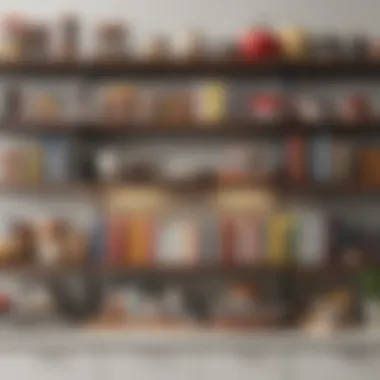

- Red: Sauces and appetizers
- Green: Vegetarian and health-conscious cookbooks
- Blue: Seafood and tropical cuisine
By engaging in this visually vibrant arrangement, you personalize your shelving while also creating a captivating focal point in your kitchen. Guests will surely notice how each book contributes to a harmonious display.
"Organization is not just about keeping things tidy; it’s about creating a space that reflects your love for cooking and inspires you every time you step into your kitchen."
These three organization techniques—categorizing by cuisine, chronological arrangement, and color coding—offer varied yet equally engaging avenues for showcasing your beloved cookbook collection. By implementing them, you not only elevate the physical appearance of your kitchen but also enrich your cooking experience.
Decorative Elements in Cookbook Shelving
Cookbook shelving serves more than just a functional purpose; it can be an artistic expression of your culinary passion. Decorative elements bring life to your kitchen, offering an opportunity to showcase your personality alongside your culinary prowess. Engaging with these elements can transform mundane storage into an inviting display. In this section, we dive into how decorations can enhance both function and form in your cookbook shelving.
Incorporating Personal Touches
Personal touches have the power to turn a simple cookbook shelf into a unique reflection of you. Think of family heirlooms, trinkets from your travels, or even art that resonates with your journey in the kitchen. Perhaps a vintage spice jar collection or a framed photo of a beloved family gathering can sit proudly alongside your cookbooks, instilling warmth and nostalgia.
- Memorable Objects: Incorporating items that tell your story brings layers to your shelf. It might be a set of measuring spoons from a cherished relative, or a decorative plate collected from a memorable vacation.
- Layering Textures: Mixing materials like wood, ceramic, and metal can add depth. A wooden shelf decorated with ceramic kitchenware creates a cozy farmhouse feel, while a sleek metal shelf with glass jars aligns well with a contemporary vibe.
Creating a Thematic Display
A thematic display allows for creativity while organizing your cookbooks. By choosing a specific theme, you can develop a cohesive look that ties your books and decorative elements together. Think about how a culinary theme can echo throughout the design.
- Cuisine-Centric Themes: For example, if Italian cuisine is your forte, consider displaying Italian cookbooks alongside decorative elements that reflect Italy, like traditional pasta jars or even a small picture of the Italian countryside.
- Seasonal Displays: Additionally, why not take advantage of changing seasons? Decorate your shelves differently from spring blossoms to autumn harvests, integrating cookbooks with seasonal items. A few pinecones and rustic candles in the fall can enhance the mood and focus on comfort food recipes.
- Color Coordination: Color can also play a major role. Arrange your books by color to create a visually appealing effect. To add even more sophistication, choose decorative pieces that complement the colors of your cookbooks, elevating the overall aesthetic of your shelf.
"Your cookbook shelf is not just about storage; it is a canvas where your culinary journey meets your unique style."
Integrating decorative elements into your cookbook shelving not only optimizes space but also creates an engaging visual experience. By incorporating personal touches and embracing themes, you can curate a display that not only functions well but also inspires creativity and culinary exploration.
Maintaining Your Cookbook Collection
Maintaining your cookbook collection is not just about keeping the shelves tidy. It involves a deeper commitment to preserving the knowledge, culinary culture, and recipes passed down through generations. Cookbooks are repositories of our culinary history—each one tells a story that weaves in personal experiences and cultural heritage. Therefore, an organized and well-maintained collection not only enhances the aesthetic of your kitchen but also makes it easier to support your culinary adventures.
One major aspect is the ease of access. When cookbooks are clean and orderly, it translates to a pleasant cooking experience. Imagine reaching for a book without guessing if it's been buried under a pile of others. This not only saves time but also encourages the exploration of new recipes—who knows what culinary gem might be hiding in that neglected book?
Dusting and Care Techniques
Just like a well-loved cast-iron skillet, your cookbooks need some TLC too. Cookbooks can easily gather dust, mainly if they’re tucked away in a corner or on a higher shelf. Regular dusting is essential, not only to keep them looking sharp but also to prevent dust or moisture damage. Here are some simple yet effective dusting and care techniques:
- Use a microfiber cloth: A lightly dampened microfiber cloth picks up dust without leaving behind scratches. Wipe down the covers and the edges of the pages consistently to keep them fresh.
- Avoid harsh cleaners: Most cookbooks will not respond well to heavy cleaners. Instead, stick to gentle solutions—sometimes, just a little water does the trick.
- Store upright: When you tuck your cookbooks away, ensure they are upright and not leaning. This preserves their spine alignment and prevents bending.
"An organized cookbook shelf isn't just aesthetically pleasing; it's a treasure trove waiting to boost your culinary creativity."
These small practices contribute significantly to the longevity of your cookbooks. They also make it easier to spot any signs of wear or damage that may need attention.
Updating Your Collection
As trends in cooking and food preferences transform, so too should your cookbook collection. Regularly updating this collection can ensure that it reflects your evolving tastes and that you always have access to fresh inspiration. Here are some considerations to keep in mind while updating your collection:
- Assess your current inventory: Examine each book—ask yourself if you still find relevance in them. If a cookbook hasn’t been opened in years, it might be time to consider parting ways.
- Embrace new cuisines: With the world becoming more connected, there are countless new culinary influences available. Whether it's authentic Thai dishes, the art of French patisserie, or even vegan recipes, updating your collection allows you to explore these flavors.
- Follow the seasonal updates: Each year or season, new cookbooks hit the shelves. Make it a habit to look out for fresh releases that can inspire your cooking techniques with innovative recipes and tips.
- Balance practical use with a touch of nostalgia: Keep those beloved family cookbooks that carry memories, but do not hesitate to let go of books that don’t spark joy or curiosity anymore. You can even donate them so someone else can create their own culinary stories.
Updating your collection ensures that every meal becomes a journey instead of a chore. It opens worlds of taste, traditions, and techniques to enrich your culinary skill.
Final Thoughts on Cookbook Shelving
The journey through the world of cookbook shelving reveals much about both organization and a love for culinary arts. As we've navigated various shelving solutions, materials, and organization techniques, it's clear that the choices we make in this area reflect a deeper appreciation for the recipes and stories our cookbooks hold. The importance of careful shelving cannot be overstated; it allows us to cultivate not just a collection, but a vibrant culinary library that sparks creativity.
Embracing Practicality and Aesthetics
In the realm of kitchen design, practicality often dances with aesthetics, and nowhere is this more evident than in cookbook storage. When selecting shelves, understanding how they can enhance functionality is key. For instance, using a well-constructed wall-mounted shelf frees up counter space while keeping your cookbooks accessible and in full view. This balance allows each book to be a part of your kitchen’s decor, making it not just a storage solution but a conversation piece.
- Mixing Styles: Consider integrating various shelving types—for example, pairing a rustic wooden shelf with sleek metal bookends. This creates visual interest and allows each cookbook to shine while also serving its purpose.
- Color Consideration: Choosing shelving that complements your kitchen’s color scheme elevates the overall design. A thoughtfully chosen shade enhances the aesthetics without overpowering the space.
- Functional Decor: Using decorative containers on your shelves can both store kitchen gadgets and lend charm. Consider ceramic jars or stylish baskets that align with your decor.
A cohesive blend of practicality and aesthetics leads to a functional kitchen environment that nurtures the cooking experience.
Enhancing the Culinary Experience Through Design
The design of your cookbook shelving can significantly influence your culinary journey. An inviting space inspires cooking, and that significance should not be overlooked. The way you choose to display cookbooks can evoke an atmosphere of warmth and creativity, encouraging you to explore new recipes and flavors.
- Personalization: Shaping your shelving around personal taste—perhaps displaying cookbooks that reflect your heritage—creates a narrative that speaks to who you are as a cook.
- Curated Collections: Beyond functionality, consider how a thematic arrangement can celebrate your cooking style. Whether you focus on vegetarian recipes or international cuisines, this can show off your personal journey through food.
- Easy Access: Thoughtful arrangement allows you to easily reach for inspiration. Shelves that are at eye level present the opportunity to instantly connect with your collection, reminding you of favorites and hidden gems.
"The kitchen is the heart of the home"—an adage that rings particularly true when your cookbook collection sparks joy and creativity.
In summary, establishing effective and artistic cookbook shelving transforms your cooking space. By considering both functionality and beauty, you envelop yourself in an environment that celebrates your culinary adventures. Investing time into your cookbook collection is not merely about tidiness; it cultivates a deeper connection to the art of cooking that one can truly appreciate.


